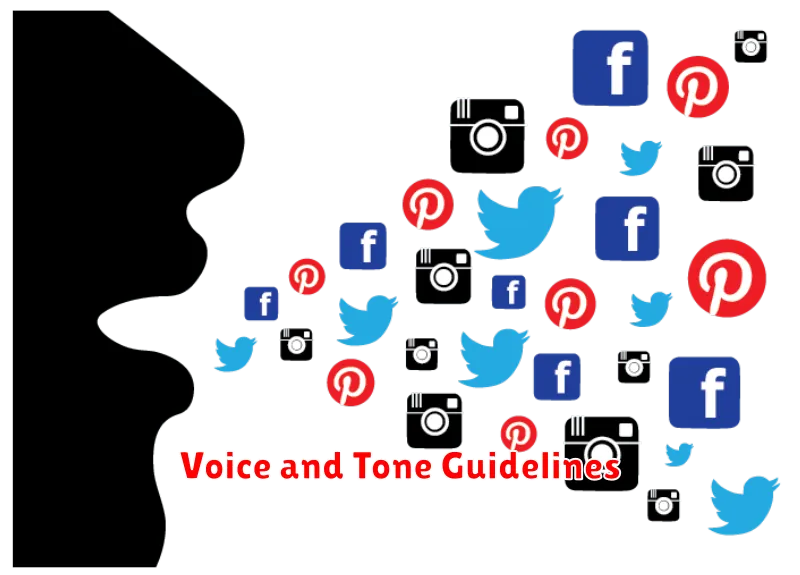In today’s digital landscape, a strong social media presence is crucial for any organization seeking to connect with its audience, build brand recognition, and achieve its marketing objectives. A well-crafted social media style guide ensures consistent branding, messaging, and voice across all platforms, contributing to a cohesive and professional online identity. This comprehensive guide serves as a valuable resource for content creators, social media managers, and anyone involved in representing your brand online, empowering them to create engaging and effective content that aligns with your overall communication strategy. By establishing clear guidelines for tone, visuals, language, and engagement, a social media style guide fosters brand consistency and strengthens your online presence.
Developing a social media style guide is a strategic investment that yields significant returns. It streamlines content creation, reduces the risk of inconsistencies, and ensures that every post reflects your brand’s values and personality. This document will delve into the essential elements of a successful social media style guide, providing practical advice and actionable steps for creating one tailored to your organization’s specific needs. From defining your brand voice and target audience to establishing guidelines for hashtags and responding to comments, we’ll cover everything you need to know to create a social media style guide that empowers your team and elevates your brand’s online presence.
What Is a Social Media Style Guide?
A social media style guide is a comprehensive document outlining how your brand presents itself across various social media platforms. It ensures consistency in voice, tone, and visual elements, creating a unified and recognizable online presence.
Think of it as a rulebook for your social media team. It dictates everything from grammar and punctuation to image usage and hashtag conventions. By adhering to these guidelines, your brand maintains a professional and cohesive image, strengthening brand recognition and fostering trust with your audience.
A well-crafted style guide covers key areas like voice and tone, language, grammar and mechanics, visual branding (logo usage, color palettes, fonts), posting frequency and timing, hashtag usage, responding to comments and messages, and crisis communication protocols.
Why Your Brand Needs One
A social media style guide ensures consistent brand representation across all platforms. It dictates the tone of voice, visual elements, and overall messaging, creating a unified and recognizable online presence.
This consistency fosters brand recognition and builds trust with your audience. When your brand communicates with a clear and consistent voice, it reinforces your values and strengthens your identity in the digital space.
A style guide also streamlines content creation. By providing clear guidelines, it empowers your team to create effective and on-brand content efficiently, eliminating guesswork and ensuring a cohesive brand experience.
Finally, a well-defined style guide helps manage risk. It minimizes the potential for off-brand messaging or inconsistent visuals that could negatively impact your brand’s reputation.
Voice and Tone Guidelines

Establishing a consistent voice and tone is crucial for building a recognizable brand presence on social media. Your voice represents your brand’s personality, while your tone adapts to the specific context of each communication.
Voice: Define your core brand voice. Are you friendly, professional, humorous, or authoritative? Maintaining a consistent voice helps solidify your brand identity across all platforms.
Tone: While your voice remains constant, your tone should adjust based on the situation. A celebratory post will have a different tone than a customer service response. Consider the context and your audience when determining the appropriate tone.
Use this table as a quick reference for aligning your voice and tone:
| Situation | Tone |
|---|---|
| Promotional Post | Enthusiastic, Informative |
| Customer Service Response | Helpful, Empathetic |
| Announcement | Formal, Clear |
Consistency in both voice and tone helps foster trust and strengthens your brand image.
Visual Identity Across Platforms
Maintaining a consistent visual identity across various social media platforms is crucial for brand recognition. While each platform has its own unique specifications and best practices, your core visual elements should remain constant.
This includes using the same profile picture (or variations of it suitable for different platform dimensions) and cover photos/banners that reflect your brand’s personality and current campaigns. Color palettes should be consistent across platforms, reinforcing brand recognition.
Typography choices also play a role in visual consistency. While you may not be able to directly control font choices on all platforms, maintaining a consistent style (e.g., serif vs. sans-serif, formal vs. informal) in your graphics and text-based content helps create a unified brand experience.
Consider creating platform-specific templates for common post types. This ensures consistent placement of logos, use of brand colors, and overall post layout, regardless of the platform. This streamlines content creation and strengthens your visual identity.
Content Types and Formats
Establishing consistent content types and formats is crucial for a cohesive brand presence. This section outlines the acceptable formats and types of content for our social media channels.
Text Posts: Keep text posts concise and engaging. Use strong calls to action where appropriate. The ideal length of a text post will vary depending on the platform, but aim for brevity.
Image Posts: Use high-quality images that align with our brand aesthetics. Ensure images are appropriately sized for each platform. Infographics and data visualizations are encouraged.
Video Content: Short, engaging videos perform well. Consider using captions for accessibility and to cater to users who watch without sound. Live videos can be used strategically for announcements and Q&A sessions.
Stories: Leverage stories for behind-the-scenes content and interactive features like polls and quizzes. Keep stories visually appealing and concise.
Hashtag Usage and Policies
Hashtags are essential for increasing visibility and discoverability on social media platforms. This section outlines how to effectively use hashtags while adhering to brand guidelines.
Research relevant and trending hashtags within your industry. Use a mix of branded hashtags (unique to your company) and general hashtags that align with your content and target audience.
Limit the number of hashtags per post. While the optimal number varies by platform, avoid excessive hashtag use, which can appear spammy. A suggested range is between 3-10 hashtags, prioritizing quality over quantity.
Maintain a consistent brand voice and message across all hashtag usage. Ensure hashtags accurately reflect the content being shared. Avoid using irrelevant or misleading hashtags simply to gain visibility.
Monitor hashtag performance. Track which hashtags generate the most engagement and refine your strategy accordingly. Stay updated on trending hashtags and adapt to changes in social media algorithms and user behavior.
Handling Negative Comments
Negative comments are an inevitable part of having a social media presence. A consistent and professional approach to handling them is crucial for maintaining a positive brand image.
Never delete negative comments unless they violate your community guidelines (e.g., hate speech, spam). Deleting legitimate criticism can fuel further negativity and damage your credibility. Instead, address the comment publicly and politely. Acknowledge the user’s concern and offer a solution or further assistance.
If the comment requires a more in-depth response or involves sensitive information, take the conversation offline. Invite the user to contact you directly via private message or email to discuss the issue further. This shows a willingness to engage and resolve the problem individually.
For frequently asked questions or recurring complaints, create a Frequently Asked Questions (FAQ) section on your social media profiles or website. This proactively addresses common concerns and reduces the need for repetitive responses.
Monitor the tone and language used in your responses. Maintain a calm and respectful demeanor, even when faced with hostile or unreasonable comments. Remember that your responses are public and reflect on your brand.
Scheduling and Posting Frequency
Establishing a consistent posting schedule is crucial for maintaining an active social media presence and maximizing reach. Consistency helps build audience anticipation and reinforces brand recognition.
The optimal posting frequency varies depending on the platform and target audience. Experiment to find what resonates best. Over-posting can lead to audience fatigue, while under-posting can result in decreased visibility. Track engagement metrics to refine your strategy.
Utilizing a social media scheduling tool is highly recommended. These tools allow for efficient content planning and automated posting, ensuring a consistent flow of content even during non-working hours. They also provide valuable analytics for performance tracking.
Create a content calendar to map out planned posts. This will help maintain a balanced content mix and prevent repetitive messaging. Consider the timing of your posts in relation to your target audience’s activity patterns for maximum impact.
Example Guidelines from Top Brands
Examining established brands’ social media style guides offers valuable insights. Consistency is a key takeaway. Brands like Coca-Cola maintain a consistent brand voice and visual identity across platforms. This includes specific guidelines for logo usage, color palettes, and typography.
Tone of voice is another crucial element. Mailchimp, known for its playful and quirky personality, reflects this in its social media communications. Their guidelines likely emphasize humor and approachability while maintaining professionalism. Conversely, a brand like Microsoft might prioritize a more formal and informative tone.
Many brands also provide specific instructions regarding hashtag usage. This often includes preferred hashtags, guidance on creating campaign-specific hashtags, and limitations on the number of hashtags per post. These guidelines help maintain a cohesive brand presence and optimize content discoverability.
Keeping Your Guide Updated
Maintaining an up-to-date social media style guide is crucial for consistency and effectiveness. Social media platforms are constantly evolving, so your guide needs to adapt to these changes. Regular reviews are essential.
Establish a review schedule. Quarterly reviews are often sufficient for most organizations, but faster-paced industries might require more frequent updates. Consider assigning someone the responsibility of monitoring platform changes and industry best practices.
During reviews, examine every section of your guide. Verify that the voice and tone guidelines still align with your brand. Confirm that the visual guidelines reflect current trends and platform updates. Check if the engagement guidelines address new features and functionalities.
Document all updates and clearly communicate changes to your team. This ensures everyone is aware of the latest guidelines and can implement them effectively. A version control system can be beneficial for tracking revisions and maintaining a history of changes.

